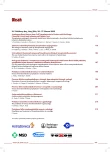Preparation of patients on anticoagulant treatment for invasive surgery
Authors:
M. Brejcha 1; J. Gumulec 2; M. Penka 3; D. Klodová 1; M. Wróbel 1; E. Bogoczová 1
Authors‘ workplace:
Hematologické oddělení, Onkologické centrum J. G. Mendela Nový Jičín, přednosta prim. MUDr. Martin Brejcha
1; Hemato-onkologické a transfuzní centrum FN Ostrava, přednosta prim. MUDr. Jaromír Gumulec
2; Oddělení klinické hematologie FN Brno, pracoviště Bohunice, přednosta prof. MUDr. Miroslav Penka, CSc.
3
Published in:
Vnitř Lék 2009; 55(3): 272-275
Category:
15th Parizek's Days
Overview
The management of warfarin therapy in patients undergoing surgery or other invasive procedures involves a balance between the risk of hemorrhage, and the risk of thrombosis. Risk of hemorrhage and the trombosis depends on the type of procedure and on pre‑existing conditions. Procedures with low risk of hemorrhage (dental, dermatologic or ophtalmologic procedures, endoscopy) can be provided with continuing anticoagulant therapy. Surgery with high hemorrhagic risk need stop warfarin and start bridging anticoagulant therapy, such as unfractionated heparin or low molecular weight heparin, prior and after surgery. In patients requiring emergency surgery, vitamin K, prothrombin complex concentrate or fresh frozen plasma can be used to improve coagulation.
Key words:
anticoagulant therapy – bridging therapy
Sources
1. Geerts WH, Bergqvist D, Pineo GF et al. Prevention of venous thromboembolism: American College of Chest Physicians evidence‑based clinical practice guidelines (8th ed). Chest 2008; 133: 381–453.
2. Kearon C, Kahn SR, Agnelli G et al. Antithrombotic therapy for venous thromboembolic disease: American College of Chest Physicians evidence‑based clinical practice guidelines (8th ed). Chest 2008; 1: 454–545.
3. Singer DE, Albers GW, Dalen JE et al. Antithrombotic therapy in atrial fibrilation: American College of Chest Physicians evidence‑based clinical practice guidelines (8th ed). Chest 2008; 133: 546–592.
4. Harrington RA, Becker RC, Cannon CP et al. Antithrombotic therapy for non‑ST segment elevation acute coronary syndromes. American College of Chest Physicians evidence‑based clinical practice guidelines (8th ed). Chest 2008; 133: 670–707.
5. Goodman SG, Menon V, Cannon CP et al. Acute-ST segment elevation myocardial infarcton. American College of Chest Physicians evidence‑based clinical practice guidelines (8th ed). Chest 2008; 133: 708–775.
6. Salem DN, O’Gara PT, Madias Ch et al. Valvular and structural heart disease: American College of Chest Physicians evidence‑based clinical practice guidelines (8th ed). Chest 2008; 133: 593–629.
7. Hirsh J, Dalen JE, Deykin D et al. Oral anticoagulants: mechanism of action, clinical effectiveness, and optimal therapeutic range. Chest 1995; 108 (Suppl): 231S–246S.
8. Becker RC, Ansell J. Antithrombotic therapy: an abbreviated reference for clinicians. Arch Intern Med 1995; 155: 149–161.
9. Kearon C, Hirsh J. Management of anticoagulantion before and after elective surgery. N Engl J Med 1997; 336: 1506–1511.
10. Dunn AS, Turpie AGG. Perioperative management of patients on oral anticoagulants: a systematic review. Arch Intern Med 2003; 163: 901–908.
11. Penka M. Perorální antikoagulační léčba. Int Med pro praxi 2003; 4: 3–6.
12. White RH, McKittrick T, Hutchinson R et al. Temporary discontinuation of warfarin therapy: changes in the international normalized ratio. Ann Intern Med 1995; 122: 40–42.
13. Torn M, Rosendaal FR. Oral anticoagulation in surgical procedures: risk and recommendations. Br J Haematol 2003; 123: 676–682.
14. Wahl MJ. Dental surgery in anticoagulated patients. Arch Intern Med 1998; 158: 1610–1616.
15. Patatanian E, Fugate SE. Hemostatic mouthwashes in anticoagulated patients undergoing dental extraction. Ann Pharmacother 2006; 40: 2205–2210.
16. Mc Mahon LB. Anticoagulants and cataract surgery. J Cataract Refract Surg 1988; 14: 569–571.
17. Robinson GA, Nylander A. Warfarin and cataract extraction. Br J Opthalmol 1989; 73: 702–703.
18. Roberts CW, Woods SM, Turner LS. Cataract surgery in anticoagulated patients. J Cataract Refract Surg 1991; 17: 309–312.
19. Alcalay J. Cutaneous surgery in patients receiving warfarin therapy. Dermatol Surg 1997; 27: 756–758.
20. Eisen GM, Baron TH, Dominitz JA et al. Guideline on the management of anticoagulation and antiplatelet therapy for endoscopic procedures. Gastrointest Endosc 2002; 55: 775–779.
21. Douketis J, Berger PB, Dunn AS et al. The perioperative management of antithrombotic therapy: American College of Chest Physicians evidence‑based clinical practice guidelines (8th ed). Chest 2008; 133: 299–339.
22. Douketis JD, Johnson JA, Turpie AG. Low-molecular-weight heparin as bridging anticoagulation during interruption of warfarin. Arch Intern Med 2004; 164: 1319–1326.
23. Dezzee KJ, Shimeall WT, Douglas KM et al. Treatment of excessive anticoagulation with phytodione (vitamin K): a meta‑analysis. Arch Intern Med 2006; 166: 391–397.
24. Baker RI, Coughlin PB, Gallus AS et al. Warfarin reversal: consensus guidelines, on behalf Australasian Society of Thrombosis and Haemostasis. Med J Aust 2004; 181: 492–497.
25. Pindur G, Mörsdorf S. The use of prothrombin complex concentrates in the treatment of hemorrhages induced by oral anticoagulation. Thromb Res 1999; 95 (4 Suppl 1): S57–S61.
Labels
Diabetology Endocrinology Internal medicineArticle was published in
Internal Medicine

2009 Issue 3
Most read in this issue
- Laboratory procedures following thrombocytopenia diagnosis
- Pre‑operative care for cardiac surgery patients with cold antibody disorder, cryoglobulinaemia and cryofibrinogenemia
- Venous thromboembolism prophylaxis in orthopaedics and traumatology
- Antithrombotic prophylaxis during pregnancy
